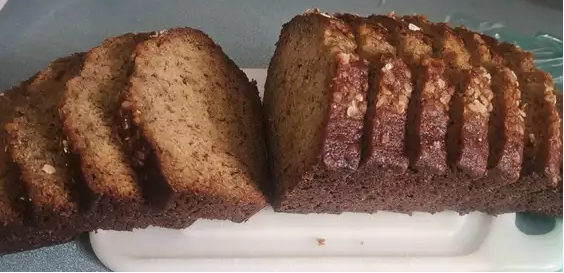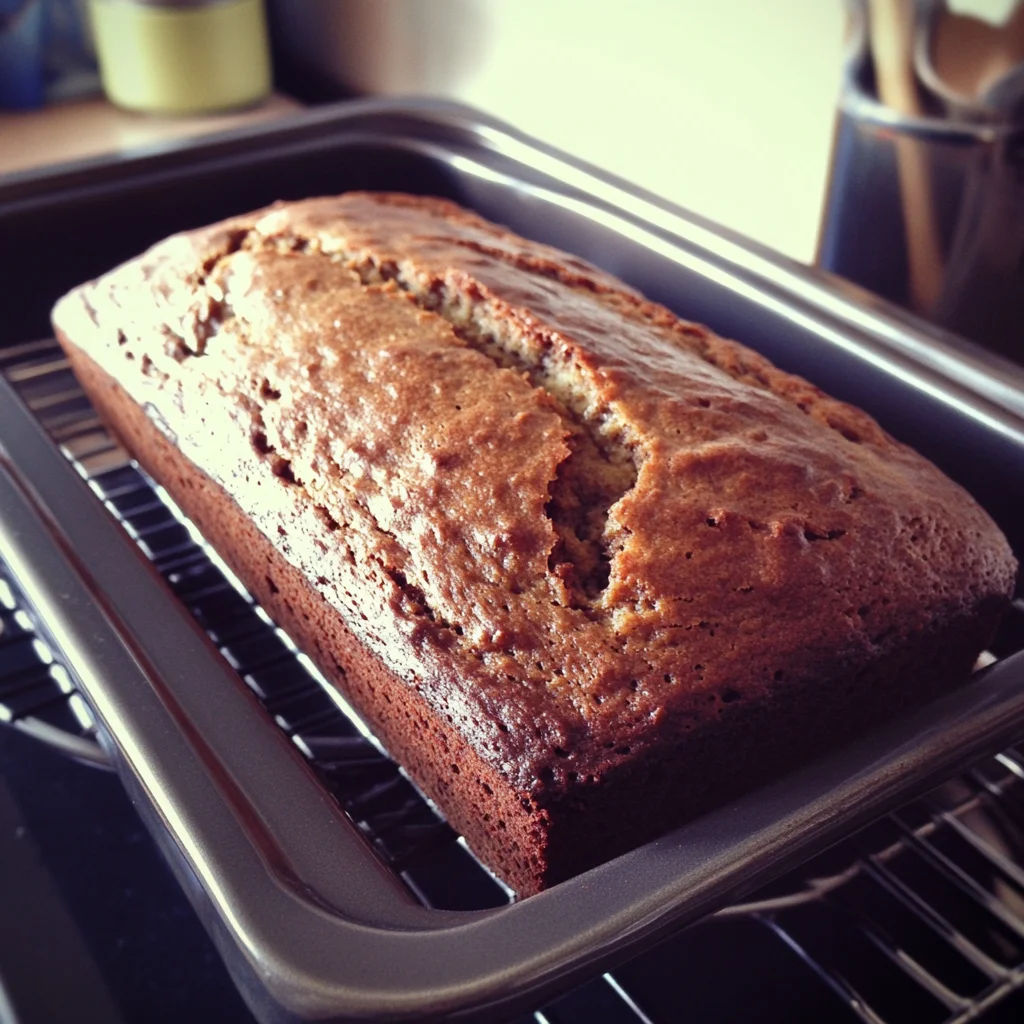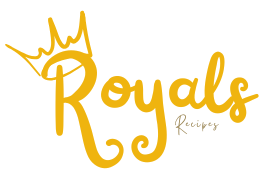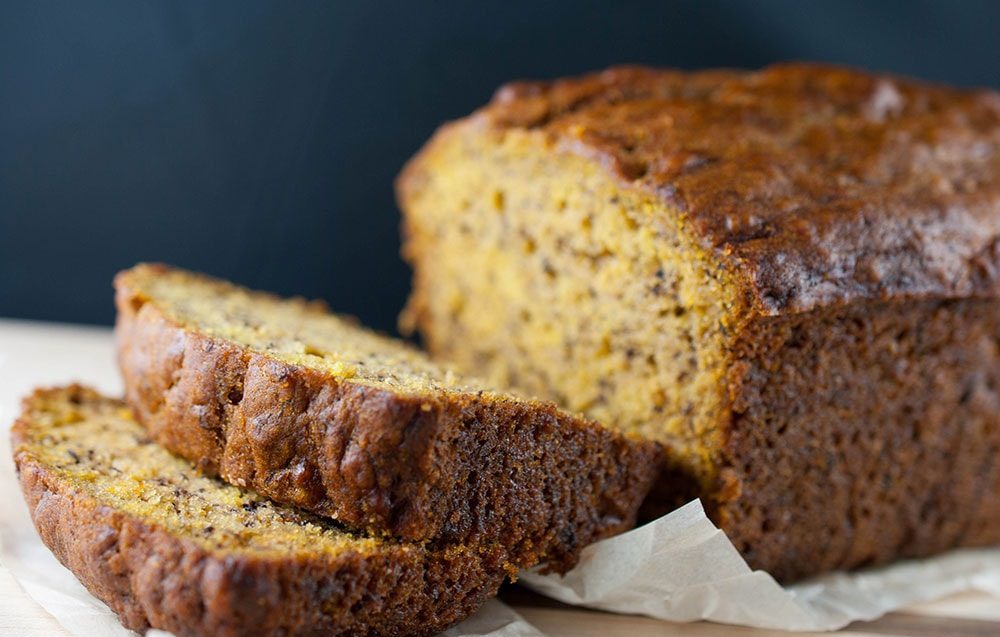5 Reasons Why This is the ultimate Banana bread is one of the most beloved baked goods around the world. Its warm, sweet aroma and comforting taste evoke feelings of home and tradition. Whether you’re an experienced baker or a beginner looking for a simple yet rewarding recipe, banana bread is the perfect choice. Plus, it’s a fantastic way to use up overripe bananas, minimizing food waste while creating a delicious treat.
This article will walk you through the ultimate banana bread recipe, along with tips, creative variations, and answers to common questions. Let’s get baking!https://royalesrecipes.com/banana-bread-recipe-with-sour-cream/

In This Recipe
Ingredients
A good banana bread recipe starts with the right ingredients. Each element plays a vital role in creating a moist, flavorful loaf. Below is a list of the core ingredients you’ll need, along with optional add-ins to customize your banana bread.
Core Ingredients
- Ripe Bananas (3 medium-sized bananas):
Overripe bananas with brown spots are ideal. They’re sweeter and mash easily, providing moisture and natural sweetness. - All-Purpose Flour (2 cups):
The base of your bread. For a healthier option, you can use whole wheat flour or a mix of both. - Sugar (¾ cup):
Granulated sugar is standard, but brown sugar can be used for a richer flavor. - Butter (½ cup, melted):
Provides a rich, buttery taste. For a dairy-free version, substitute with coconut oil or a neutral vegetable oil. - Eggs (2 large):
Helps bind the ingredients together and provides structure to the bread. - Baking Soda (1 teaspoon):
The leavening agent that helps the bread rise, making it light and fluffy. - Salt (½ teaspoon):
Balances the sweetness and enhances the flavor of the bananas. - Vanilla Extract (1 teaspoon):
Adds a subtle depth of flavor.
Optional Add-Ins
- Chocolate Chips (½ cup):
Perfect for chocolate lovers, adding a sweet twist to the classic recipe. - Chopped Nuts (½ cup):
Walnuts or pecans add a delightful crunch and nutty flavor. - Spices (1 teaspoon cinnamon or nutmeg):
Spices elevate the aroma and add warmth to the bread. - Dried Fruits (½ cup):
Raisins, cranberries, or chopped dates can bring a chewy texture and extra sweetness. - Yogurt or Sour Cream (¼ cup):
Boosts the moisture level and gives a tangy undertone. - Shredded Coconut (¼ cup):
A tropical twist for adventurous bakers.
Customizing Sweetness Levels
- For a sweeter loaf: Add an extra ¼ cup of sugar or drizzle with honey after baking.
- For less sweetness: Reduce the sugar to ½ cup or skip the optional add-ins like chocolate chips.
Equipment Needed
Creating the perfect banana bread doesn’t require a professional kitchen. With a few basic tools and alternatives for common kitchen equipment, you can whip up a delicious loaf with ease.
Essential Kitchen Tools
- Mixing Bowls (2):
One for dry ingredients and one for wet ingredients. Medium to large bowls work best to avoid spillage. - Whisk or Fork:
Used to mash bananas and mix wet ingredients thoroughly. - Measuring Cups and Spoons:
For precise measurement of dry and liquid ingredients. - Spatula or Wooden Spoon:
To gently fold the wet and dry ingredients together. - Loaf Pan (9×5 inches):
The standard size for most banana bread recipes. If unavailable, smaller pans or muffin tins can be used, but baking time will vary. - Oven:
Preheated to 350°F (175°C) for even baking. - Wire Rack:
To cool the bread evenly and prevent sogginess at the bottom.
Optional Equipment
- Hand Mixer or Stand Mixer:
While not necessary, these can save time when blending wet ingredients, especially if using butter. - Parchment Paper:
For easy removal of the bread from the loaf pan and reduced cleanup. - Kitchen Scale:
Helps ensure accurate measurements, particularly if you’re experimenting with substitutions or baking in high altitudes.
Alternatives for Beginners
If you’re just starting out and don’t have some of the equipment mentioned above to prepare banana bread, here are some easy substitutions:
- Mixing Bowls:
Use any large, clean container like a salad bowl or even a pot. - Loaf Pan:
Muffin tins, cake pans, or even oven-safe glass containers can work. Just be mindful of the cooking time. - Measuring Cups:
If you don’t have a set, use a standard cup or tablespoon for approximate measurements. - Wire Rack:
Place the bread on an inverted plate or any heat-safe surface that allows airflow underneath.
Prepping Your Workspace
Before starting, it’s important to prep your kitchen to ensure smooth baking:
- Grease your loaf pan with butter or non-stick spray, or line it with parchment paper.
- Preheat the oven to 350°F (175°C). This ensures the batter starts baking immediately.
- Organize your ingredients and tools for easy access during the process.
With the ingredients and tools ready, let’s move on to the fun part—making the banana bread!
Step-by-Step Instructions
Making banana bread is a straightforward process that’s perfect for bakers of all skill levels. Follow these detailed steps to create a loaf that’s moist, flavorful, and perfectly baked.
“For additional baking tips and techniques, explore our Guide to Perfect Baking.”
Preparing the Ingredients
- Choose and Mash the Bananas:
- Select overripe bananas with brown spots for maximum sweetness and flavor.
- Use a fork or potato masher to mash the bananas into a smooth puree. A few small lumps are fine—they’ll add texture to the bread.
- Measure and Organize Ingredients:
- Accurately measure all the ingredients and arrange them within reach. This helps prevent mistakes and ensures a smooth baking process.
Mixing the Batter
- Combine Dry Ingredients:
- In a medium bowl, whisk together 2 cups of flour, 1 teaspoon of baking soda, and ½ teaspoon of salt. This ensures even distribution and prevents clumps.
- Mix Wet Ingredients:
- In a separate large bowl, whisk or beat 2 eggs until lightly frothy.
- Add ¾ cup of sugar, ½ cup of melted butter, 1 teaspoon of vanilla extract, and the mashed bananas. Mix until smooth.
- Combine Wet and Dry Mixtures:
- Gradually add the dry ingredients into the wet ingredients, folding gently with a spatula or wooden spoon. Avoid overmixing, as this can make the bread dense.
- Incorporate Optional Add-Ins:
- If using chocolate chips, nuts, or other mix-ins, gently fold them into the batter until evenly distributed.
Baking the Banana Bread
- Prepare the Pan:
- Grease a 9×5-inch loaf pan with butter or cooking spray. Alternatively, line it with parchment paper for easy removal.
- Pour the Batter:
- Pour the batter into the prepared pan, spreading it evenly with a spatula.
- Bake:
- Place the pan in the center of the preheated oven and bake at 350°F (175°C) for 50-60 minutes.
- Check for doneness by inserting a toothpick into the center. If it comes out clean or with a few crumbs, the bread is ready.
Discover essential baking tips for beginners https://www.kingarthurbaking.com/learn/guides/baking
Cooling and Serving
- Cool in the Pan:
- Allow the bread to cool in the pan for about 10 minutes. This helps it set and makes removal easier.
- Transfer to a Wire Rack:
- Run a knife along the edges of the loaf pan to loosen the bread. Carefully turn it out onto a wire rack to cool completely.
- Slice and Serve:
- Once cooled, slice the banana bread with a sharp knife and serve. It pairs wonderfully with coffee, tea, or a dollop of butter.
Storage Tips
- At Room Temperature:
- Wrap the bread in plastic wrap or store it in an airtight container for up to 3 days.
- In the Refrigerator:
- Keep it in a sealed container for up to 7 days to maintain freshness.
- In the Freezer:
- Wrap individual slices in plastic wrap and store them in a freezer-safe bag for up to 3 months. Thaw at room temperature or reheat in the microwave.
Tips for Perfect Banana Bread
Creating the perfect banana bread goes beyond just following a recipe. Small details, such as ingredient selection and preparation techniques, can make a significant difference in the final product. Below are expert tips to ensure your banana bread is moist, flavorful, and irresistibly delicious.

Choosing the Best Bananas for bread banana
- Go for Overripe Bananas:
- The best bananas for banana bread are heavily speckled with brown spots or even completely brown. These bananas are sweeter and easier to mash.
- Ripening Bananas Quickly:
- If your bananas aren’t ripe enough, place them in a paper bag for 1-2 days to speed up the ripening process. Alternatively, bake them in the oven at 300°F (150°C) for 15-20 minutes until the skins turn black.
- Avoid Using Green Bananas:
- Underripe bananas lack the natural sweetness and softness needed for a perfect loaf.
Avoiding Common Mistakes
- Don’t Overmix the Batter:
- Overmixing activates the gluten in the flour, leading to dense and tough bread. Mix just until the ingredients are combined.
- Measure Ingredients Accurately:
- Use measuring cups for dry ingredients and liquid measuring cups for wet ones. Level off dry ingredients with a knife to avoid packing.
- Use Room Temperature Ingredients:
- Ingredients like eggs and butter blend more evenly at room temperature, resulting in a smoother batter.
- Check Oven Accuracy:
- Use an oven thermometer to ensure the temperature is correct. Even a slight variance can affect baking time and texture.
Adjusting for Dietary Preferences
- Healthier Substitutions:
- Swap all-purpose flour with whole wheat flour for added fiber.
- Replace sugar with honey, maple syrup, or a natural sweetener like stevia.
- Use Greek yogurt instead of butter for a lower-fat option.
- Vegan Alternatives:
- Replace eggs with flaxseed meal (1 tablespoon mixed with 2.5 tablespoons water per egg).
- Substitute butter with coconut oil or a plant-based margarine.
- Gluten-Free Option:
- Use a 1:1 gluten-free flour blend. Add a teaspoon of xanthan gum if the blend doesn’t already include it.
Achieving the Perfect Texture
- Moist Bread:
- Add ¼ cup of sour cream or yogurt to the batter to keep the bread extra moist.
- Avoid overbaking by checking the bread 5 minutes before the suggested baking time.
- Light and Fluffy Bread:
- Sift the flour before mixing to aerate it and reduce clumps.
- Beat the eggs until frothy for added lightness.
- Crispy Crust:
- Sprinkle a small amount of granulated sugar on top of the batter before baking to create a lightly crisp and caramelized crust.
Enhancing the Flavor
- Spices and Extracts:
- Add a teaspoon of cinnamon, nutmeg, or a mix of warm spices for a spiced loaf.
- Swap vanilla extract with almond extract for a nutty twist.
- Flavor-Infused Add-Ins:
- Mix in a tablespoon of espresso powder or cocoa for a mocha banana bread.
- Fold in orange zest for a refreshing citrus flavor.
By mastering these tips, you’ll achieve a bakery-quality banana bread every time. Let’s move on to some creative variations that will take your banana bread game to the next level.
Creative Variations
While the classic banana bread recipe is a beloved favorite, experimenting with unique ingredients and flavors can elevate your loaf to new heights. Below are some creative variations to inspire your baking journey.
Chocolate Chip Banana Bread
- Ingredients:
- Add ½ to 1 cup of semisweet or dark chocolate chips to the batter.
- Sprinkle a few extra chips on top of the loaf before baking for a melty topping.
- Flavor Profile:
- The richness of chocolate pairs perfectly with the sweetness of bananas, creating a dessert-like treat.
- Optional Enhancements:
- Mix in a tablespoon of cocoa powder for double chocolate banana bread.
- Add a pinch of sea salt for a sweet-and-salty combination.
Nutty Banana Bread
- Ingredients:
- Stir in ½ cup of chopped nuts, such as walnuts, pecans, or almonds.
- For added texture, sprinkle crushed nuts on top of the batter before baking.
- Flavor Profile:
- The crunchy, nutty texture contrasts beautifully with the soft and moist bread.
- Optional Enhancements:
- Toast the nuts beforehand to bring out their natural oils and enhance the flavor.
- Add a swirl of peanut or almond butter to the batter for an indulgent twist.
Vegan Banana Bread
- Ingredients:
- Replace eggs with flax eggs (1 tablespoon flaxseed meal + 2.5 tablespoons water per egg).
- Use plant-based milk, like almond or oat milk, instead of dairy.
- Substitute butter with coconut oil or vegan margarine.
- Flavor Profile:
- This version retains the classic banana flavor while being entirely plant-based.
- Optional Enhancements:
- Add a handful of vegan chocolate chips or dried fruits for variety.
- Use coconut sugar or agave syrup as a natural sweetener.
Gluten-Free Banana Bread
- Ingredients:
- Replace all-purpose flour with a gluten-free baking blend.
- Add 1 teaspoon of xanthan gum if the blend doesn’t include it.
- Flavor Profile:
- The gluten-free version is just as moist and flavorful as the original, with no compromise in texture.
- Optional Enhancements:
- Mix in gluten-free oats for added fiber and texture.
- Top with a sprinkle of chia or flax seeds for a health boost.
Tropical Banana Bread
- Ingredients:
- Mix in ½ cup of shredded coconut and ½ cup of chopped dried pineapple.
- Add 1 teaspoon of rum extract for a hint of tropical flavor.
- Flavor Profile:
- The coconut and pineapple create a refreshing, island-inspired twist on the classic recipe.
- Optional Enhancements:
- Replace regular sugar with coconut sugar for a more robust, caramel-like sweetness.
- Add macadamia nuts for a truly tropical experience.
Seasonal Banana Bread Variations
- Fall-Inspired:
- Add ½ cup of pumpkin puree and a teaspoon of pumpkin pie spice for a fall-flavored loaf.
- Swirl in caramel or butterscotch chips for extra decadence.
- Summer-Inspired:
- Fold in fresh berries like blueberries or raspberries for a light, fruity variation.
- Top with a drizzle of lemon glaze for a refreshing finish.
Creative Presentation Ideas
- Muffins:
- Divide the batter into a muffin tin for individual servings. Adjust the baking time to 18-22 minutes.
- Layered Banana Cake:
- Slice the loaf horizontally and layer it with cream cheese frosting or Nutella for a special occasion dessert.
- Mini Loaves:
- Use mini loaf pans for gift-sized banana bread. Bake for 30-35 minutes.
These creative variations make banana bread endlessly versatile, whether you’re catering to dietary needs, seasonal flavors, or personal taste preferences. Next, we’ll explore the health benefits of banana bread and how to make it a nutritious treat.
Health Benefits of Banana Bread
While banana bread recipe is often considered a comfort food, it can also provide nutritional value when prepared thoughtfully. From the natural goodness of bananas to smart ingredient substitutions, this treat can strike a balance between indulgence and health. Learn more about the health benefits of bananas https://www.healthline.com/nutrition/11-proven-benefits-of-bananas
Nutritional Value of Bananas
- Rich in Potassium:
- Bananas are an excellent source of potassium, which supports heart health, muscle function, and blood pressure regulation.
- High in Fiber:
- A medium banana contains about 3 grams of fiber, aiding digestion and promoting a feeling of fullness.
- Natural Sugars:
- The natural sweetness of bananas reduces the need for added sugars in recipes.
- Source of Vitamins and Minerals:
- Bananas are packed with vitamin C, vitamin B6, and magnesium, all of which contribute to overall well-being.
Healthier Ingredient Substitutions
By making small adjustments to the traditional recipe, you can create a banana bread that aligns with various health goals:
- Reducing Sugar:
- Use natural sweeteners like honey, maple syrup, or mashed dates instead of granulated sugar.
- Rely on the sweetness of ripe bananas to cut sugar content by half.
- Replacing Butter:
- Substitute butter with unsweetened applesauce, Greek yogurt, or mashed avocado for a lower-fat alternative.
- Using Whole Grains:
- Replace all-purpose flour with whole wheat flour or oat flour to add fiber and nutrients.
- Adding Superfoods:
- Mix in flaxseed, chia seeds, or hemp seeds to boost omega-3s and fiber content.
- Incorporating Protein:
- Add a scoop of protein powder or mix in a handful of nuts to increase the protein content.
Balancing the Macros
For a well-rounded banana bread that fits into a balanced diet, focus on incorporating healthy fats, carbohydrates, and protein:
- Carbohydrates:
- Bananas and whole-grain flour provide complex carbs that release energy slowly.
- Healthy Fats:
- Nuts, seeds, and coconut oil offer unsaturated fats that are good for heart health.
- Protein:
- Eggs, Greek yogurt, and nuts contribute protein to keep you satiated.
Banana Bread for Special Diets
- Vegan Banana Bread:
- Exclude dairy and eggs by using plant-based milk and flax eggs.
- Gluten-Free Banana Bread:
- Use almond flour, oat flour, or a gluten-free blend for those with gluten intolerance.
- Low-Calorie Banana Bread:
- Reduce sugar, use low-fat substitutes, and bake smaller portions to control calorie intake.
- Keto-Friendly Banana Bread:
- Substitute bananas with banana extract, use almond flour, and replace sugar with erythritol or stevia.
Why Banana Bread is a Smart Choice
- Portion Control:
- Banana bread can be baked into muffins or mini loaves for easy portioning, helping you manage intake.
- Satisfying Sweet Cravings:
- It’s a healthier alternative to cakes or cookies, especially when made with reduced sugar and whole grains.
- Energy Boost:
- The combination of carbs and natural sugars makes banana bread an excellent pre-workout or midday snack.
Pairing Banana Bread with Healthy Additions
- Toppings:
- Add a dollop of almond butter, a drizzle of honey, or a sprinkle of chia seeds for extra nutrition.
- Accompaniments:
- Pair a slice of banana bread with a smoothie, fresh fruit, or a side of Greek yogurt for a wholesome breakfast or snack.
- Beverages:
- Enjoy it with green tea, black coffee, or a glass of unsweetened almond milk to balance the sweetness.
With these adjustments, banana bread recipe can be a guilt-free indulgence that provides nutritional benefits. Next, we’ll address some frequently asked questions to resolve common queries about making and storing banana bread.
Frequently Asked Questions (FAQs)
Banana bread recipe is a simple and versatile, but questions often arise about its preparation, storage, and troubleshooting. Here are detailed answers to the most common queries.
How Do You Store Banana Bread?
- At Room Temperature:
- Wrap the bread tightly in plastic wrap, aluminum foil, or store it in an airtight container. It will stay fresh for up to 3 days.
- In the Refrigerator:
- For longer storage, refrigerate the bread in an airtight container for up to 7 days. Note that refrigeration may make it slightly denser.
- In the Freezer:
- To freeze, wrap individual slices or the whole loaf in plastic wrap, then place in a freezer-safe bag or container. It can last up to 3 months.
- To thaw, leave it at room temperature or warm it in the microwave for 20-30 seconds.
Can Banana Bread Be Frozen?
Yes, banana bread freezes exceptionally well! Follow these steps for best results:
- Freezing the Whole Loaf:
- Wrap the loaf tightly in plastic wrap and a layer of foil for double protection against freezer burn.
- Freezing Individual Slices:
- Slice the bread after it has cooled completely. Wrap each slice individually in plastic wrap and store them together in a freezer bag.
- Thawing:
- Thaw individual slices or the whole loaf at room temperature. To enjoy warm, heat slices in the microwave or toaster oven.
What Type of Bananas Are Best?
- Overripe Bananas:
- The best bananas are heavily speckled with brown or almost completely brown. These bananas are soft, sweet, and perfect for mashing.
- Too Ripe Bananas:
- If bananas are black and overly mushy, they may still work, but inspect for any fermented odor or off taste before using.
- Ripening Hack:
- If you have underripe bananas, bake them in the oven at 300°F (150°C) for 15-20 minutes to quickly soften them.
Why Did My Banana Bread Turn Out Dry?
- Overbaking:
- If the bread is baked too long or at a high temperature, it can dry out. Use a toothpick to check for doneness and remove it as soon as it comes out clean.
- Incorrect Measurements:
- Too much flour or too little liquid can make the bread dry. Measure ingredients accurately using the scoop-and-level method.
- Not Enough Bananas:
- Ensure you’re using at least 3 medium-sized bananas for sufficient moisture.
- Skipping Add-Ins:
- Adding sour cream, yogurt, or even an extra banana can boost the moisture content.
Bonus Question: Can I Make Banana Bread into Muffins?
Absolutely! Banana bread batter works perfectly for muffins. Follow these tips:
- Preparation:
- Grease a muffin tin or line it with paper liners. Divide the batter evenly among the cups.
- Baking Time:
- Reduce the baking time to 18-22 minutes at 350°F (175°C). Test for doneness with a toothpick.
- Serving:
- Muffins are great for individual portions and make an easy grab-and-go breakfast or snack.
With these FAQs answered, you’re ready to tackle any banana bread-related challenges. Next, let’s wrap up with a quick recap and some final thoughts.
Conclusion
Banana bread is more than just a recipe; it’s a timeless comfort food that brings joy to countless kitchens worldwide. Whether you’re a seasoned baker or a beginner, the simplicity and versatility of banana bread make it a go-to choice for using overripe bananas and experimenting with flavors.
In this article, we’ve explored the essential ingredients, necessary equipment, and a step-by-step guide to making the perfect loaf. From tips to ensure your bread is moist and flavorful to creative variations like chocolate chip, vegan, or gluten-free banana bread, there’s something here for everyone. We’ve also covered health benefits, substitutions, and answers to common questions to empower you in your banana bread-making journey.
The beauty of banana bread recipe lies in its adaptability. Whether you enjoy it as a classic recipe or with unique twists, it’s a treat that fits any occasion, from breakfast to dessert. So, preheat your oven, grab those overripe bananas, and get baking! Your ultimate banana bread masterpiece awaits.

